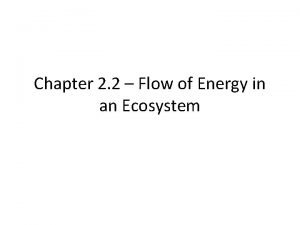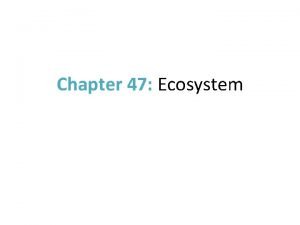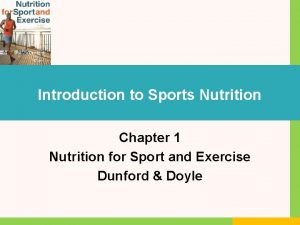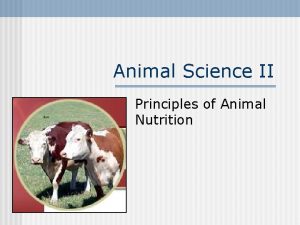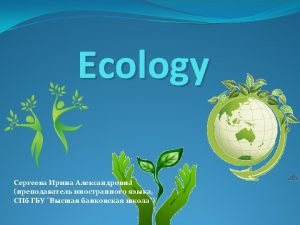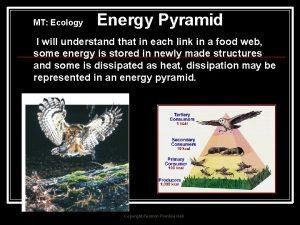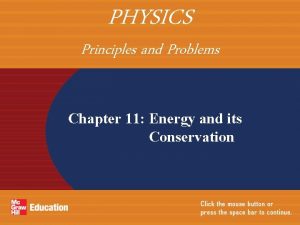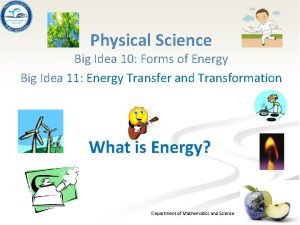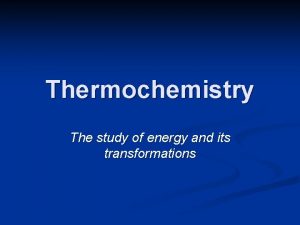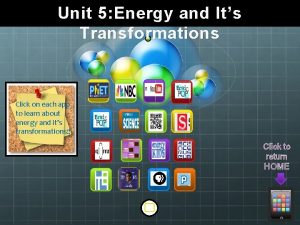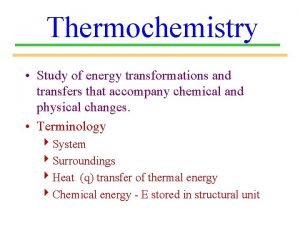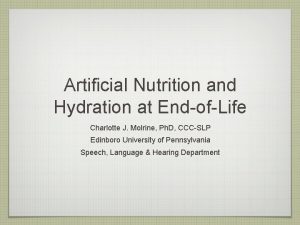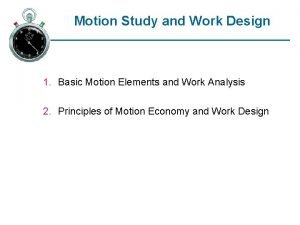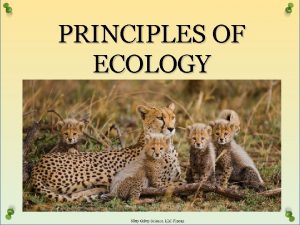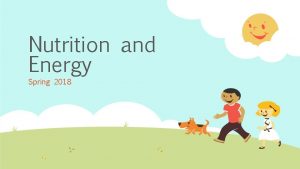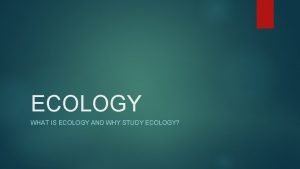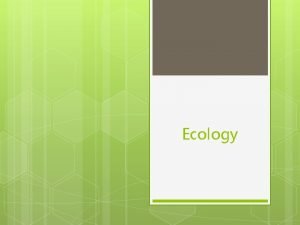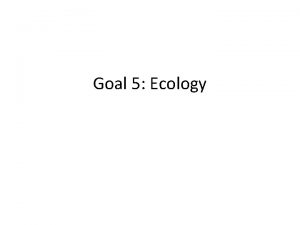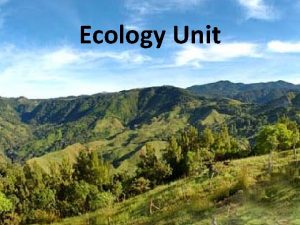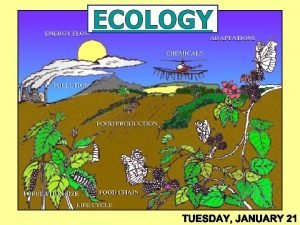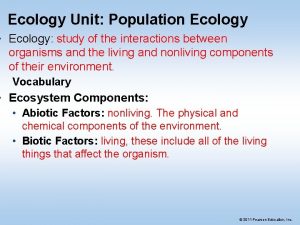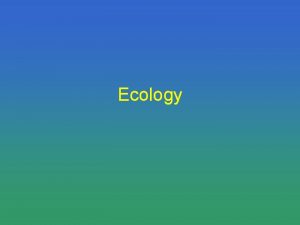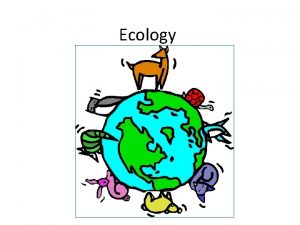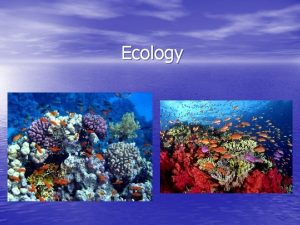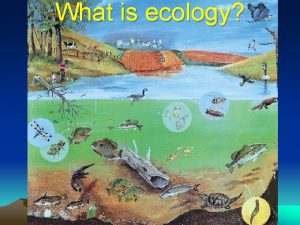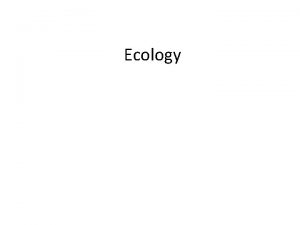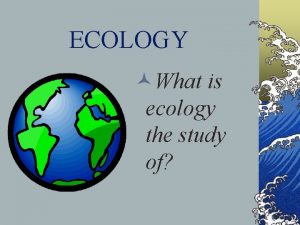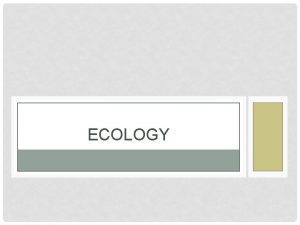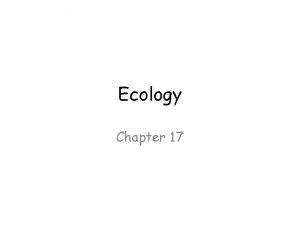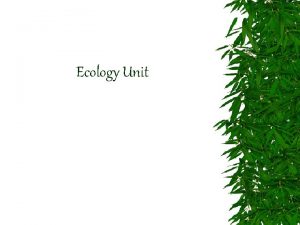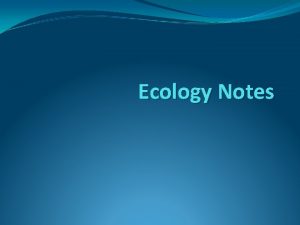PRINCIPLES OF ECOLOGY NUTRITION AND ENERGY Ecology Study






































- Slides: 38

PRINCIPLES OF ECOLOGY

NUTRITION AND ENERGY

Ecology Study of the interactions among organisms and between organisms and their environment Ecologists study the flow of energy through communities to discover nutritional relationships between organisms. SUNLIGHT is the main energy source for life on Earth.

Autotrophs Organisms that use sunlight or energy stored in chemical compounds to make food because they make their own food — producers

Photosynthesis Process used by autotrophs to make food energy from sun, plants, algae, cyanobacteria

Chemosynthesis Autotrophs that capture chemical energy since they live in places without sunlight bacteria found in volcano vents, hot springs, tidal marshes

Heterotrophs Organisms that rely on other organisms for their energy and food supply; also called consumers Heterotroph Herbivore Carnivore Omnivore Detritivore Description eats only plants eat only animals eat both plant and animals eat plant and animal remains Examples cows, caterpillars, deer snakes, owls, sharks humans, bears, crows worms, crabs, mites Decomposers — break down organic matter Ex. bacteria & fungi

ENERGY FLOW IN ECOSYSTEMS

Energy flows through an ecosystem in one direction from the sun or chemical compounds to autotrophs (producers) and then to various heterotrophs (consumers).

Food chains — show matter and energy move through ecosystem in a series of steps showing which organisms transfer energy by eating and being eaten.

Each organism in a food chain represents a feeding step, or trophic level, in the transfer of matter and energy.

Food webs Models that show all possible feeding relationships at each trophic level in a community; links all food chains in an ecosystem together.

Biological pyramid Diagram that shows amounts of energy or matter at each trophic level; three different types:

Snake 10 kcal Fox (10) Mice 100 kcal Birds (25) Insects 1000 kcal Grasshoppers (250) Producers 10, 000 kcal Grasses (3000) ENERGY PYRAMID 80 g PYRAMID OF NUMBERS Human 800 g Chicken 8000 g Grain BIOMASS PYRAMID

CYCLES IN NATURE

Biogeochemical cycles Elements, compounds, and other forms of matter are passed from one organism to another and from one part of the biosphere to another; Connect biological, geological and chemical aspects

The Water Cycle Water is constantly moving between the atmosphere & Earth.

The Carbon Cycle

Carbon plays many roles – 4 main processes move carbon: —Biological processes, such as photosynthesis, respiration and decomposition —Burial and decomposition of dead organisms and their conversion under pressure (fossil fuel) —Geochemical processes, such as erosion and volcanic activity release CO 2 —Mining, cutting and burning forests, burning fossil fuels

The Nitrogen Cycle The atmosphere is the main reservoir of nitrogen; it also cycles through the soil and tissues of living organisms.

The Phosphorus Cycle Phosphorus in biosphere cycles among the land, ocean sediments and living organisms.

ORGANISMS AND THEIR ENVIRONMENTS

Biotic factors All the living organisms in an environment Abiotic factors The non-living parts of the environment ex. climate, wind, nutrient availability, soil and sunlight

Habitat An area where an organism lives — includes both biotic and abiotic factors. Niche All strategies and adaptations a species uses in its environment, including: § type of food an organism eats § how it obtains food and shelter § when and how a specie reproduces and survives *No two species can share the same niche in the same habitat*

Symbiosis Any relationship in which two species live closely together Symbiosis Mutualism Description both species benefit from relationship Commensalism one organism benefits and the other is neither helped nor harmed Parasitism one organism lives on or in organism and harms it Example flowers & insects rhino & tick bird tress & moss whales & barnacles dogs & ticks human & mosquito Predators — organisms that seek out and eat other organisms Prey — organisms that are eaten

ECOLOGICAL SUCCESSION

Community Made up of populations of organisms that live in a common area

Limiting factor Anything that limits an organism’s ability to live in a particular environment Ex. lack of water causes grass to die causing certain herd population to decrease.

Tolerance The ability of living things to survive the changes in their environment.

Succession The process of gradual, natural, change and species replacement that takes place in the communities of an ecosystem over time.

Primary Succession Secondary Succession — takes place on land where — pattern of changes that takes place there are no living after an existing community is organisms Ex. after volcano destroyed erupts — first species to populate the — fires set by lightning, farming, area are pioneer species floods are examples — eventually pioneer species — may take shorter time to reach die adding organic material climax community since soil to help form soil for plants already exists Climax Community — a stable community formed after primary or secondary succession once little or no change occurs.

BIOMES

Each biome is defined by a unique set of abiotic factors — particularly climate — and a diverse group of plants and animals. Biome — large group of ecosystems that shares the same type of climax community. Biomes located on land are terrestrial biomes. Biomes located in bodies of water are known as aquatic biomes.

Aquatic Biomes Water makes up the largest part of the biosphere covering approximately 75 percent of Earth’s surface. The aquatic biome can be broken down into two basic regions — freshwater and marine.

Freshwater Has low salt concentration — usually less than 1 percent (ponds & lakes, streams & rivers, wetlands)

Marine Cover about ¾ of Earth’s surface and includes oceans, coral reefs, and estuaries.

Terrestrial Biomes Terrestrial biomes vary greatly. Climate is a group of abiotic factors that influence the type of climax community that develops in area.

The most common terrestrial biomes that result from climate differences are tundra, taigas, deserts, savannahs, temperate forests and tropical rainforests.
 Principles of ecology chapter 2 section 1 answer key
Principles of ecology chapter 2 section 1 answer key Principles of ecology chapter 2 section 1 answer key
Principles of ecology chapter 2 section 1 answer key Principles of ecology 2 flow of energy in an ecosystem
Principles of ecology 2 flow of energy in an ecosystem Energy energy transfer and general energy analysis
Energy energy transfer and general energy analysis Energy energy transfer and general energy analysis
Energy energy transfer and general energy analysis Principles of ecology 1 organisms and their relationships
Principles of ecology 1 organisms and their relationships Principles of ecology section 3 cycling of matter
Principles of ecology section 3 cycling of matter Energy input and output nutrition
Energy input and output nutrition Definition of sports nutrition
Definition of sports nutrition Principles of animal science
Principles of animal science Cyq
Cyq Principles of ecology chapter 2 section 1 answer key
Principles of ecology chapter 2 section 1 answer key Ecology study guide answers
Ecology study guide answers Chapter 3 section 1: community ecology answer key
Chapter 3 section 1: community ecology answer key Ecology is the study that helps to preserve
Ecology is the study that helps to preserve Energy pyramid definition ecology
Energy pyramid definition ecology Chapter 4 assessment physics
Chapter 4 assessment physics Process of method study
Process of method study Objectives of work study
Objectives of work study Time and motion study example ppt
Time and motion study example ppt Chapter 11 study guide conservation of energy
Chapter 11 study guide conservation of energy 10 forms of energy
10 forms of energy Study of energy and its transformations
Study of energy and its transformations Phases of matter foldable
Phases of matter foldable Study jams transformations
Study jams transformations Study of energy and its transformations
Study of energy and its transformations Pros and cons of artificial nutrition and hydration
Pros and cons of artificial nutrition and hydration How understanding of motion elements and principles
How understanding of motion elements and principles Chapter 1 principles of government study guide answer key
Chapter 1 principles of government study guide answer key What is the definition of chemical potential energy
What is the definition of chemical potential energy Primary energy and secondary energy
Primary energy and secondary energy What is commercial energy source
What is commercial energy source Helmholtz free energy and gibbs free energy
Helmholtz free energy and gibbs free energy Renewable energy and energy efficiency partnership
Renewable energy and energy efficiency partnership Kinetic energy and potential energy
Kinetic energy and potential energy Conservation of mechanical energy
Conservation of mechanical energy Formula of potential energy
Formula of potential energy Kinetic energy and potential energy formula
Kinetic energy and potential energy formula Eroei
Eroei


